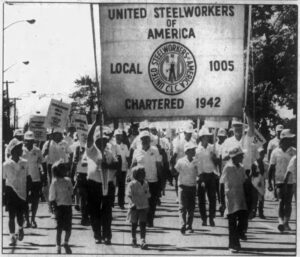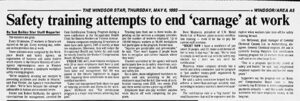

Labour Day Parade, Hamilton, 1989
The first location of the Occupational Health Clinics for Ontario Workers opened in Hamilton on February 16, 1989. Funded by the Ministry of Labour and led by a Board of Directors composed of union leaders, managers, business leaders and worker advocates, it was truly a joint initiative to address the need for workers to access occupational medicine/hygiene expertise to prevent occupational disease. Executive Director Claire Booker remarked at the time that the Board was designed “to find solutions in a non-adversarial setting.”
Hamilton was an appropriate location for the first clinic. A blue-collar town centred around factory jobs, the Labour Day Parade that year attracted 4,000 people. The new organization was to play a unique role in Ontario’s prevention system. Its inaugural opening was attended by politicians, activists and members of the labour community, and was heralded as an important first step for better occupational health and safety services. In its first few months the clinic would grow to a staff of 9, and included John Oudyk, who still works for OHCOW today as an Occupational Hygienist. The small clinic made a significant impact in those early days.
A Much Needed Service
It has never been an easy road for injured workers to receive compensation, and at that time, claim denials were the norm, and often not even attempted. Family doctors were unfamiliar with evaluating occupational diseases. Union-run clinics had existed in the region since 1980 but were plagued by funding problems and other challenges. Medical facilities run by the Workers’ Compensation Board (Now WSIB) or employer-owned corporate clinics were perceived as biased.
This set the stage for a fully funded yet independent organization to fairly assess workplace injury claims and respond to workers’ concerns about safety protocols at their jobs. The detection of occupational injuries and illnesses, and proactive work to prevent and eliminate them, was OHCOW’s stated goal.
New Attitudes, Expanding Knowledge
Medical evidence for the accumulating effects of long-term exposure to hazardous substances had been mounting for years, and the Workplace Hazardous Materials Information System (WHMIS) had recently been introduced. New approaches to the treatment and prevention of strain injuries were starting to come to the forefront. The time had come for employers to follow through on their responsibility to implement safety training and preventive measures at their workplaces.
OHCOW’s Longest Serving Employee

John Oudyk
In 1989, John Oudyk had worked at foundries in the region and at the WCB, and had a Degree in Chemical Engineering. His credentials and background gave him a well-rounded perspective on the issues surrounding occupational health and safety. Upon being hired as an Occupational Hygienist at the Hamilton clinic in May of that year, he was faced with a buildup of denied WCB claims to go through, and plenty of requests for workplace tours at factories and manufacturing plants.
The first few months after John got there, plenty of productive discussion took place with his colleagues. They developed a unique set of protocols for dealing with a wide range of clients who had different health and safety concerns. John formalized a method of creating a retrospective exposure profile for workers. He would draw attention from other occupational health organizations for his success in winning claims for his clients, particularly those with lung disease.
The office was a close-knit group. They all felt the responsibility and the satisfaction of being part of a movement that could make such a difference in people’s lives. It was customary for them to do workplace tours as a team. When an injured worker could not travel, they visited the worker at their home, to gather information through interviews and to make a personal connection with the people they were helping.
One of OHCOW’s First Cases
The health hazard posed by asbestos in some older buildings was a major issue at the time. Among OHCOW’s first clients were parents at the Six Nations reserve, who launched a boycott of their children's schools due to the presence of asbestos and the overall dilapidated state of the buildings. Health inspectors tried to dismiss the concerns. As part of OHCOW’s investigation, John dealt directly with the parents, teachers and community leaders, reviewing hygiene reports and interviewing thirty teachers. In 1991, the first brand new elementary school opened on the reserve.
OHCOW Evolves
By the mid-1990s OHCOW had expanded into other regions, and there was less emphasis on industrial work and more on the services and health care sectors. With more women working, the effect of chemical exposure on fetal development was also at the forefront. Most importantly, Illness “clusters” were being acknowledged. A “cluster” is a case involving a group of workers in a workplace who experience the same illness, pointing to a persistent health hazard at that workplace. As medical profiles and testing became more complex, OHCOW clinicians knew they had to stay informed about current medical research and occupational health news.
It is remarkably easy today to share information through the internet, a convenience not available in the early 1990s. John collected information from the library at the Canadian Centre for Occupational Health and Safety (CCOHS), by photocopying journal articles and printing from microfiche, or copying articles onto floppy discs and CDs. He curated an abundance of useful information, which was shared with colleagues and other partners. Visitors would see photocopied articles on his desk and ask for a copy. “Information was the bottleneck,” says John.
The Windsor Clinic and “Workplace Carnage”
A year after the Windsor clinic opened in 1992, the Windsor Star published an article citing shocking statistics from the Workplace Health and Safety Agency. The article dramatically referred to a state of ‘carnage’ in the workplace. This was not an exaggeration. Twenty-seven workers were injured on the job every ten minutes in Ontario, and every day saw a workplace fatality. This further signaled an urgent need for compulsory safety training for workplaces. It was at the Windsor OHCOW office in May of 1993 that the first Core Certification Training Program was unveiled at a news conference. Ontario companies with employees 20 or more workers were required to certify at least two employees over the next two years, and failure to comply would mean a hefty fine. OHCOW played a major role in the introduction of the new required training.
OHCOW Escapes the Axe
By 1996, OHCOW had four clinics across Ontario, and was credited with having developed the largest clinical database in North America on occupational health issues. In seven years more than 6,500 workers had been OHCOW clients. Through their preventive services, it was estimated OHCOW had reached more than 22,000 workers. Nevertheless, that year the Harris government moved to disband the OHCOW clinics in a cost saving measure. Many voiced opposition, citing the huge financial and human cost of workplace injuries and illness. In an open letter, the vice-chairman of Stelco noted that “The multi-disciplined team of doctors, nurses, hygienists and ergonomists [at OHCOW] available to the workplace leads to prompt, effective and non-confrontational identification and resolution of issues.” In October, the Labour Minister stated that the clinics would not close, and worker groups, many employers, and the Ontario labour movement celebrated the reversal.
In the years going forward, OHCOW has continued to prove itself as an effective and necessary resource for workers needing accessible medical consultation and answers to questions about occupational health and safety concerns. Countless workplaces have benefitted from OHCOW’s hygiene and ergonomic assessments. To commemorate 35 years of dedicated service, clinicians, directors, staff and other supporters of the Occupational Health Clinics for Ontario Workers pledge to continue its mandate to proactively work to prevent and eliminate occupational injuries and illnesses.
Lisa Wilder
Communications Coordinator
Do you have memories and/or photos of OHCOW's first years, 1989-1999? Let us know!
Bibliography
Interview with John Oudyk
Bailey, Sue. “Safety Training Attempts to End Carnage at Work.” The Windsor Star (Windsor, Ontario, Canada) · 6 May 1993, Thursday
Grey-Grant, Jennifer. “Asbestos Removal Costs High.” The Burlington Spectator (Burlington, Ontario, Canada) · 26 Oct 1989, Thu
Grey-Grant, Jennifer. “Reserve School Boycott Heats Up.” The Burlington Spectator (Hamilton, Ontario, Canada) · 19 Oct 1989, Thu
Brown, Barbara. “Workers’ Clinic Health Milestone, Labour Leaders Say.” The Burlington Spectator (Hamilton, Ontario, Canada) · 18 Feb 1989, Sat
Christmas, Brian. “Hazardous Materials Code are Making Workers Aware." The Burlington Spectator (Hamilton, Ontario, Canada) · 13 Feb 1989,
Zarzour, Kim. “The Mystery of Cluster Illness.” The Toronto Star (Toronto, Ontario, Canada) · 21 Apr 1990, Sat
Prokaska, Lee. “Clinics to Stay Open.” The Hamilton Spectator (Hamilton, Ontario, Canada) · 25 Oct 1996, Fri
Eaton, Jonathan. “Cuts Threaten Injury Clinics.” The Toronto Star (Toronto, Ontario, Canada), 30 Sep 1996, Mon
Van Wageningen, Ellen. “Fight for Health Clinic, Hampton Urges Public. The Windsor Star (Windsor, Ontario, Canada )12 Oct 1996
Frangione, Rocco. “Workers Lobby to Keep Clinics Open.” The Sault Star (Sault St. Marie, Ontario, Canada) · 20 Sep 1996, Fri



Comments are closed.